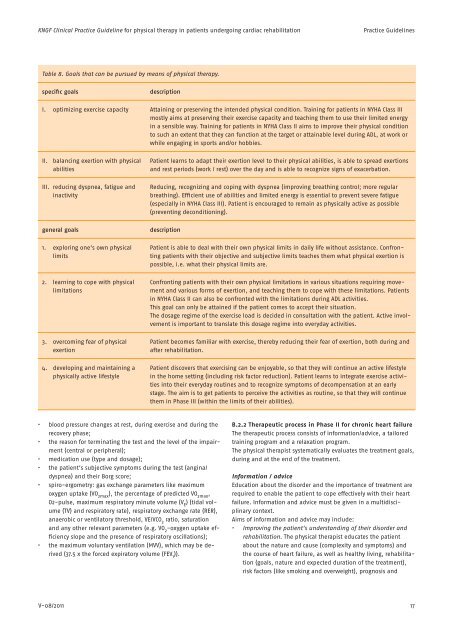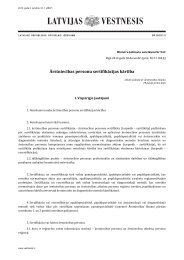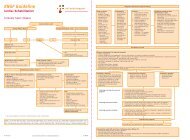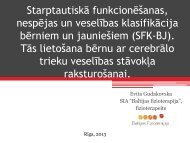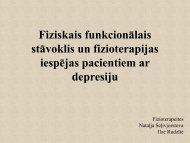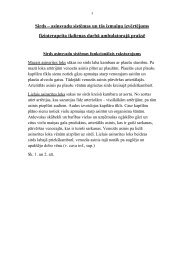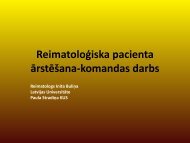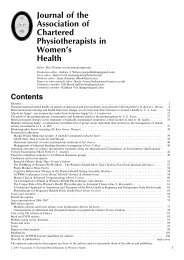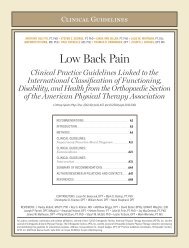KNGF Guideline Cardiac rehabilitation
KNGF Guideline Cardiac rehabilitation
KNGF Guideline Cardiac rehabilitation
You also want an ePaper? Increase the reach of your titles
YUMPU automatically turns print PDFs into web optimized ePapers that Google loves.
<strong>KNGF</strong> Clinical Practice <strong>Guideline</strong> for physical therapy in patients undergoing cardiac <strong>rehabilitation</strong><br />
Practice <strong>Guideline</strong>s<br />
Table 8. Goals that can be pursued by means of physical therapy.<br />
specific goals<br />
description<br />
I. optimizing exercise capacity Attaining or preserving the intended physical condition. Training for patients in NYHA Class III<br />
mostly aims at preserving their exercise capacity and teaching them to use their limited energy<br />
in a sensible way. Training for patients in NYHA Class II aims to improve their physical condition<br />
to such an extent that they can function at the target or attainable level during ADL, at work or<br />
while engaging in sports and/or hobbies.<br />
II. balancing exertion with physical<br />
abilities<br />
III. reducing dyspnea, fatigue and<br />
inactivity<br />
general goals<br />
1. exploring one’s own physical<br />
limits<br />
2. learning to cope with physical<br />
limitations<br />
3. overcoming fear of physical<br />
exertion<br />
4. developing and maintaining a<br />
physically active lifestyle<br />
Patient learns to adapt their exertion level to their physical abilities, is able to spread exertions<br />
and rest periods (work / rest) over the day and is able to recognize signs of exacerbation.<br />
Reducing, recognizing and coping with dyspnea (improving breathing control; more regular<br />
breathing). Efficient use of abilities and limited energy is essential to prevent severe fatigue<br />
(especially in NYHA Class III). Patient is encouraged to remain as physically active as possible<br />
(preventing deconditioning).<br />
description<br />
Patient is able to deal with their own physical limits in daily life without assistance. Confronting<br />
patients with their objective and subjective limits teaches them what physical exertion is<br />
possible, i.e. what their physical limits are.<br />
Confronting patients with their own physical limitations in various situations requiring movement<br />
and various forms of exertion, and teaching them to cope with these limitations. Patients<br />
in NYHA Class II can also be confronted with the limitations during ADL activities.<br />
This goal can only be attained if the patient comes to accept their situation.<br />
The dosage regime of the exercise load is decided in consultation with the patient. Active involvement<br />
is important to translate this dosage regime into everyday activities.<br />
Patient becomes familiar with exercise, thereby reducing their fear of exertion, both during and<br />
after <strong>rehabilitation</strong>.<br />
Patient discovers that exercising can be enjoyable, so that they will continue an active lifestyle<br />
in the home setting (including risk factor reduction). Patient learns to integrate exercise activities<br />
into their everyday routines and to recognize symptoms of decompensation at an early<br />
stage. The aim is to get patients to perceive the activities as routine, so that they will continue<br />
them in Phase III (within the limits of their abilities).<br />
• blood pressure changes at rest, during exercise and during the<br />
recovery phase;<br />
• the reason for terminating the test and the level of the impairment<br />
(central or peripheral);<br />
• medication use (type and dosage);<br />
• the patient’s subjective symptoms during the test (angina/<br />
dyspnea) and their Borg score;<br />
• spiro-ergometry: gas exchange parameters like maximum<br />
oxygen uptake (VO 2max ), the percentage of predicted VO 2max ,<br />
O2-pulse, maximum respiratory minute volume (V E ) (tidal volume<br />
(TV) and respiratory rate), respiratory exchange rate (RER),<br />
anaerobic or ventilatory threshold, VE/VCO 2 ratio, saturation<br />
and any other relevant parameters (e.g. VO 2 -oxygen uptake efficiency<br />
slope and the presence of respiratory oscillations);<br />
• the maximum voluntary ventilation (MVV), which may be derived<br />
(37.5 x the forced expiratory volume (FEV 1 )).<br />
B.2.2 Therapeutic process in Phase II for chronic heart failure<br />
The therapeutic process consists of information/advice, a tailored<br />
training program and a relaxation program.<br />
The physical therapist systematically evaluates the treatment goals,<br />
during and at the end of the treatment.<br />
Information / advice<br />
Education about the disorder and the importance of treatment are<br />
required to enable the patient to cope effectively with their heart<br />
failure. Information and advice must be given in a multidisciplinary<br />
context.<br />
Aims of information and advice may include:<br />
• Improving the patient’s understanding of their disorder and<br />
<strong>rehabilitation</strong>. The physical therapist educates the patient<br />
about the nature and cause (complexity and symptoms) and<br />
the course of heart failure, as well as healthy living, <strong>rehabilitation</strong><br />
(goals, nature and expected duration of the treatment),<br />
risk factors (like smoking and overweight), prognosis and<br />
V-08/2011<br />
17


